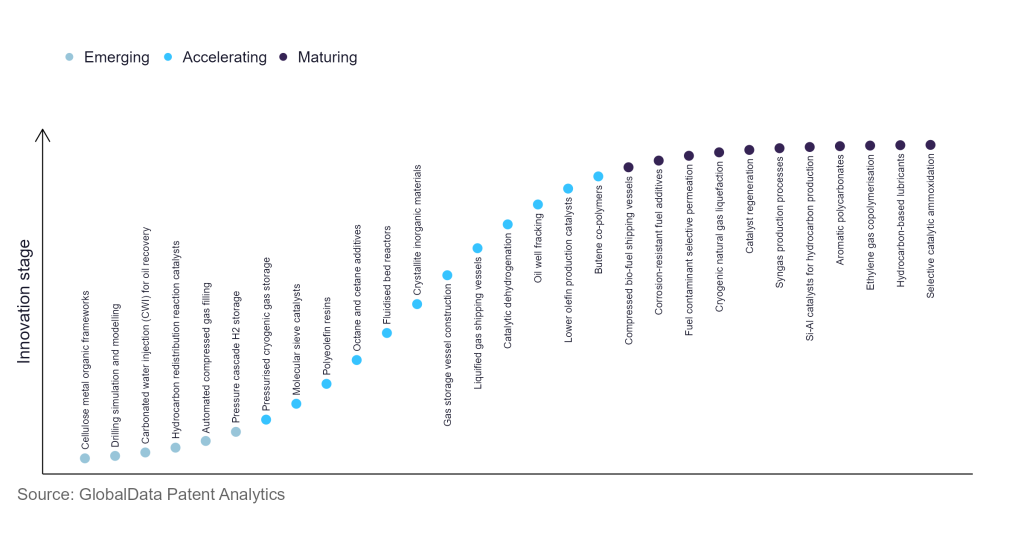The oil and gas industry continues to be a hotbed of innovation, with activity driven by the need for improved efficiency, workforce safety, reducing the carbon footprint of operations, and optimising production. Digital technologies are enabling the oil and gas industry in achieving these objectives. This is characterised by the growing importance of technologies such as artificial intelligence (AI), internet of things (IoT), and robotics in day-to-day tasks. In the last three years alone, there have been over 534,000 patents filed and granted in the oil and gas industry, according to GlobalData’s report on Innovation in Oil & Gas: Drilling simulation and modeling. Buy the report here.
However, not all innovations are equal and nor do they follow a constant upward trend. Instead, their evolution takes the form of an S-shaped curve that reflects their typical lifecycle from early emergence to accelerating adoption, before finally stabilising and reaching maturity.
Identifying where a particular innovation is on this journey, especially those that are in the emerging and accelerating stages, is essential for understanding their current level of adoption and the likely future trajectory and impact they will have.
40+ innovations will shape the oil & gas industry
According to GlobalData’s Technology Foresights, which plots the S-curve for the oil and gas industry using innovation intensity models built on over 256,000 patents, there are 40+ innovation areas that will shape the future of the industry.
Within the emerging innovation stage, drilling simulation and modelling, carbonated water injection (CWI) for oil recovery, and automated compressed gas filling are disruptive technologies that are in the early stages of application and should be tracked closely. Liquified gas shipping vessels and oil well fracking are some of the accelerating innovation areas, where adoption has been steadily increasing. Among maturing innovation areas are compressed bio-fuel shipping vessels and cryogenic natural gas liquefaction, which are now well established in the industry.
Innovation S-curve for the oil & gas industry

Drilling simulation and modelling is a key innovation area in oil & gas
Drilling simulation and modelling involves replicating the behaviour of drilling processes in a virtual environment. It is carried out for executing different projects in a safe, controlled environment, including well design, drilling equipment and material selection, and personnel training, among others. This improves the preparation before beginning with the actual drilling activities.
GlobalData’s analysis also uncovers the companies at the forefront of each innovation area and assesses the potential reach and impact of their patenting activity across different applications and geographies. According to GlobalData, there are 20+ companies, spanning technology vendors, established oil & gas companies, and up-and-coming start-ups engaged in the development and application of drilling simulation and modelling.
Key players in drilling simulation and modelling – a disruptive innovation in the oil & gas industry
‘Application diversity’ measures the number of different applications identified for each relevant patent and broadly splits companies into either ‘niche’ or ‘diversified’ innovators.
‘Geographic reach’ refers to the number of different countries each relevant patent is registered in and reflects the breadth of geographic application intended, ranging from ‘global’ to ‘local’.
Patent volumes related to drilling simulation and modelling
Source: GlobalData Patent Analytics
Halliburton, Schlumberger, and Baker Hughes are some of the leading companies in drilling simulation and modelling. Halliburton offers wide range of digital tools for exploration and production, including a drilling simulator that optimises and predicts the outcome of a variety of well operations.
Schlumberger’s drilling simulation system leverages various technologies, such as hydraulics and thermodynamics, for assessing the well discharge scenarios, and dynamic well kill operations. The company also offers tools to enhance planning of drilling operations.
Baker Hughes’ drilling simulation offers several benefits, including lowering drilling risk, delivering optimal drill results, and enabling rig site service automation.
To further understand the key themes and technologies disrupting the oil & gas industry, access GlobalData’s latest thematic research report on Top 20 Oil & Gas Themes 2022.
Data Insights
From

The gold standard of business intelligence.
Blending expert knowledge with cutting-edge technology, GlobalData’s unrivalled proprietary data will enable you to decode what’s happening in your market. You can make better informed decisions and gain a future-proof advantage over your competitors.



